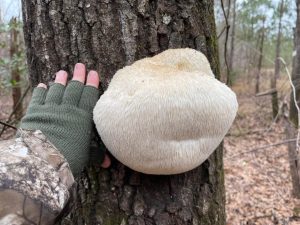
My husband’s best friend was a nature nerd like me. If I didn’t know what something was, Anthony was the first person I’d send a photo to for identification help. We lost him unexpectedly last year, but he shows up in small ways for us almost daily.

After that round of storms blew through the area a couple of weekends ago, we were helping a neighbor remove a large broken maple limb from his front yard. Looking at the fall, it was evident why this particular branch was the first to go. Significant rot had set into the crook of the tree where the branch attached, and the bark inside the downed limb was completely shredded. In addition, a huge white mushroom had grown in the same spot, an obvious indicator of decay. I am admittedly no expert on fungi, so when my husband piped up with, “Oh! That’s lion’s mane,” I was a little surprised he recognized it. Turns out, during time spent in the woods hiking with his buddy over the years, Anthony had pointed it out along trails from here to Tennessee.

Lion’s mane (Hericium spp.) is one of the larger noticeable and edible mushrooms growing in the urban and wild forests of our area. It’s found in rotting wood of dead (saprophytic) and living trees, and thrives in areas of high humidity. Frequently, it can be seen fairly high up in a living tree, where it is considered more of a parasite. Like many unusual organisms, lion’s mane has lots of other whimsical and descriptive common names, including bearded tooth, old man’s tooth, and hedgehog mushroom. The fruiting body of the mushroom is a large (3-15”) white mass, with rows of hanging toothlike spines. The fungi can live and continue fruiting for 20+ years. They are common in the eastern United States and Asia, but have been listed as endangered in parts of the UK and Europe and cannot be harvested.

Many fungi are dangerously toxic, so I cannot in good conscience suggest that someone eat a mushroom unless they know exactly what they’re looking at. So, mushroom hunt with great care and an expert who knows what they’re doing. If you find a mushroom and are curious about it, the UF Plant Pathology lab has a Fungal Herbarium with lots of useful resources. The lab provides help identifying mushrooms, along with fact sheets on popular species and direct contact with a professor specializing in mushrooms in more serious situations. A great guidebook for mushrooms is “Common Florida Mushrooms,” available online many places including the IFAS bookstore.
I have not personally tried lion’s mane mushrooms, but have heard them described as possessing a seafood/lobster flavor. The younger and fresher the better, as older mushrooms are described as “sour and bitter.” Lion’s mane extract is used to treat anxiety and depression, along with neurodegenerative diseases like Alzheimer’s and dementia. A recent study at the University of Florida Scripps Institute for Biomedical Innovation and Technology looked at the compounds found within the fungus and how they might be applicable to disease treatment. While modern medicine is working on identifying the chemical signatures, this fungal species has been used in Chinese medicine since ancient times. Due to the positive commercial applications of the mushroom, researchers at Cornell are looking at the viability of farming lion’s mane for food and medical uses.
On a related note, if you notice abnormally dark bark coloration and/or mushrooms growing on trees in your yard, it is wise to have them looked at by an arborist. With hurricane season around the corner, tree limbs exhibiting rot can be a serious hazard.
 11
11
